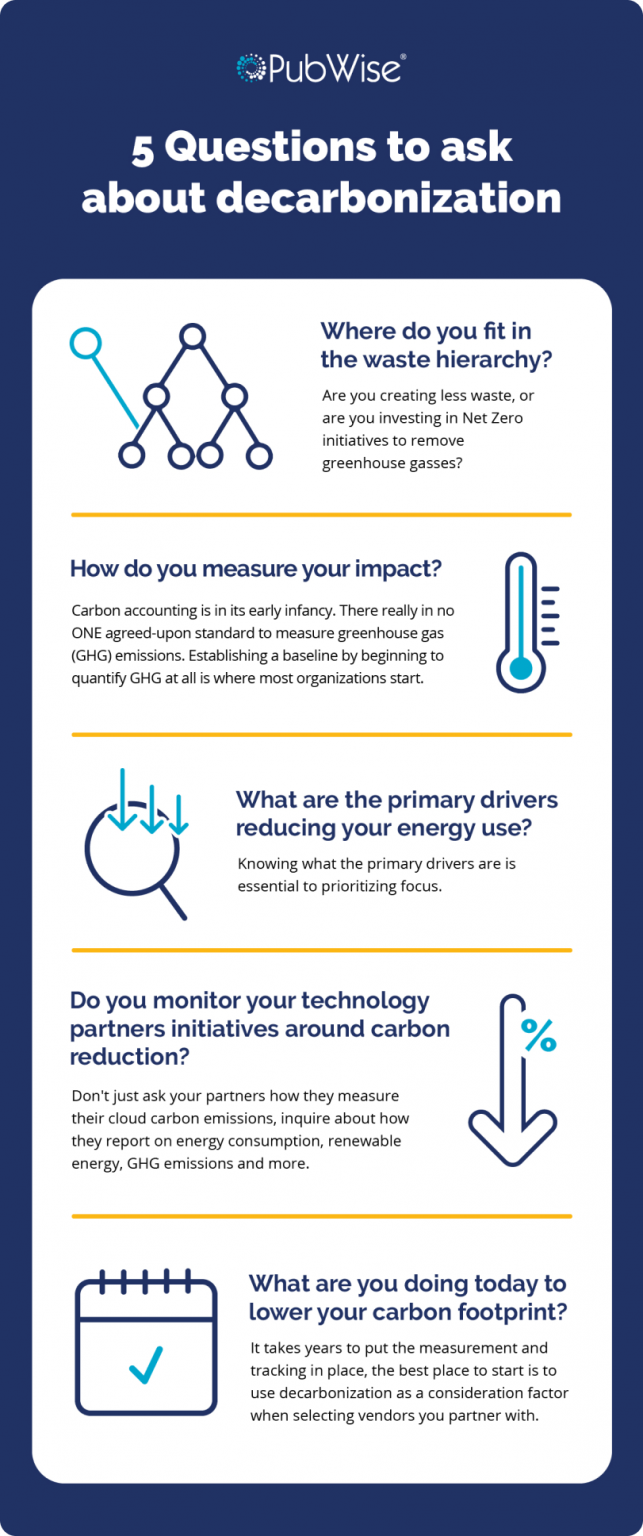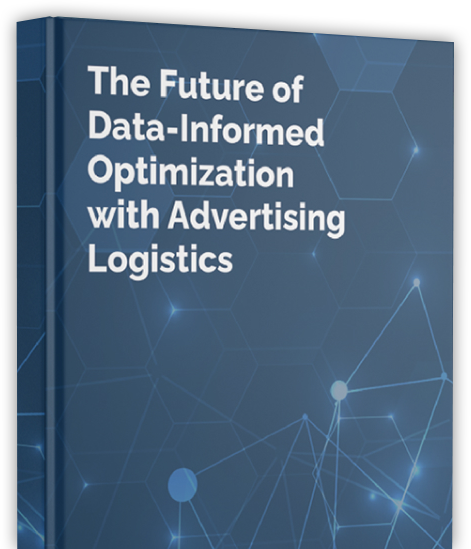
Decarbonization is all over the news and generating less carbon emissions has never been more in focus for executives concerned with corporate social responsibility (CRS). Taking steps to reduce your carbon footprint is good for your company and the planet, especially in industries like adtech that require massive amounts of processing power to operate. All can be accomplished while retaining the long term view that publishers and the ecosystem need to be profitable businesses.
There are many ways businesses can reduce their carbon footprint that, when taken collectively, can have a significant impact. Here are a few of the most common tried and tested methods:
- Use renewable energy – Electricity from renewable energy sources like solar produces significantly less greenhouse gasses (GHGs). There are 5 types of renewable energy sources that harness the power of the sun, wind, and heat from the Earth’s core, making it possible to transform it into forms of energy like heat, electricity and fuel.
- Hydro – $64 cost of energy per MWh
- Wind – $38 cost of energy per MWh
- Solar – $36 cost of energy per MWh
- Biomass – $114cost of energy per MWh
- Geothermal – $75 cost of energy per MWh
- Install energy-efficient lighting – LEDs use at least 90 percent less energy than incandescent bulbs, emit virtually no heat, and last 25 times longer.
- Take fewer in-person meetings – The carbon footprint of driving and flying and staying overnight far outweighs an online meeting. Travel mindfully.
- Choose like-minded partners – Who you partner with is an increasingly prominent element of corporate social responsibility. Many companies request that their partners comply with their own environmental policies.
- Reduce waste – Companies that reduce waste save precious resources and ease the burden on our landfills, which can have a significant impact on the environment. One of our customers, Freecycle, built their nonprofit around the concept of upcycling and preventing items from ever reaching the landfill.
At PubWise, our first love is using technology to solve problems, but our goal wasn’t to find a solution for the carbon footprint of the adtech industry. Instead, we’ve been focused on using machine learning to improve performance for our customers across the advertising supply chain, which fortunately led to making a sizable dent in carbon emissions.
The Waste Hierarchy, created by the EPA, provides a four-tiered view of waste management to guide decision-making. Waste reduction is the most preferred and has the greatest impact. While lifecycle thinking is typically applied to physical products, it also applies to services. Here at PubWise, we have chosen to focus on waste reduction, basically putting less CO2 in the atmosphere, instead of attempting to mitigate the problem with carbon offsets.
We understand that publishers and advertisers, along with other players in the digital advertising ecosystem, need to be profitable businesses; we also believe operating responsibly is part of what sets any business up for long term success.
To better understand the impact carbon action optimization can make on decarbonization, let’s first take a look at the big picture of the environmental problem everyone is trying to solve.
Machine Learning’s Contribution
Machine learning is becoming more ubiquitous, increasing its carbon footprint significantly. Data centers are faced with managing carbon emissions while meeting the growing demand for their services. While machine learning can be the cause of increased emissions, if used properly it can also identify ways to reduce emissions.
“According to the International Energy Agency, data centers consume approximately 200 terawatt-hours (TWh) of electricity, or nearly 1% of global electricity demand, contributing to 0.3% of all global CO2 emissions.”
On a site by site basis, PubWise can reduce bid volumes by as much as 40%. If a company’s historical bid volume has been around 500B transactions, PubWise can typically deliver the same revenue with only 300B impressions.
Less Bid Volume = Smaller Carbon Footprint
4 questions to get the conversation started with your technology partners
Placing a strong emphasis on the environment goes beyond measuring your carbon footprint. Recognizing the impact of your business partners is equally as important. Many companies have CSR procurement guidelines that identify the environmental principles they hold their partners accountable to. These are the questions we hear the most, and how we respond to them when clients are looking for our principles on decarbonization.
1. Where does PubWise fit in the waste hierarchy?
Here at PubWise, we focus on waste reduction, because it has the greatest impact and is the most preferred approach to managing decarbonization. Our strongest contribution to climate action is avoiding sending unnecessary bids into the programmatic ecosystem. “The energy required to compute code for advertising generates roughly two percent of the internet’s total emissions, according to data from Good-Loop, a UK-based startup that creates technology to help advertisers stick to sustainability pledges and raise money for nonprofits.”
2. How does PubWise measure its environmental impact?
Carbon accounting is in its early infancy. There really is no ONE agreed-upon standard to measure greenhouse gas (GHG) emissions. Establishing a baseline by beginning to quantify GHG at all is where most organizations start. We have machine learning logs that show our Smart Path Optimization Technology® (SPOT) actually increases fill rate and CPMs while reducing bid volume by up to 40%. The logical conclusion from that is, whatever the contribution of those extra bid requests is, we are reducing it. For our largest partners, especially those who are currently using other providers, the savings in both carbon and data center costs can be substantial.
3. What are the primary drivers reducing energy use at PubWise?
The data center is only one driver in carbon emissions when it comes to programmatic advertising, but it can have a significant impact on a company’s carbon footprint. Below are three ways in which a data center’s carbon impact can be monitored and measured:
- Electricity consumption (to run the servers)
- Water consumption (to cool the servers)
- Life cycle of the equipment (which impacts the frequency of replacements)
In addition to the actual data center, the below elements also play an important role in the carbon footprint of any programmatic advertising solution:
- Ad server
- Bid management solution including machine learning
- Impression volume
- Audience targeting
4. Do you monitor your technology partners initiatives around carbon reduction?
We are very selective about who we do business with:
- Google’s Carbon Footprint measures and reports our cloud carbon emissions
- AWS’s Customer Carbon Footprint Tool monitors carbon emissions
- Equinix tracks key environmental metrics like energy consumption, renewable energy, GHG emissions and more
Below are 5 simple questions to ask your technology partners to see how they compare.
Decarbonization Jargon
Just as adtech is known for all of its jargon, environmental terminology can also be confusing.
- Net Zero refers to the removal of all greenhouse gasses (GHGs) – such as carbon dioxide (CO2), methane or sulfur dioxide – across the entire supply chain.
- Carbon Neutral refers to the removal of carbon from the atmosphere to compensate for the amount of carbon emissions created.
- Carbon Offsetting is a climate balance practice used to reduce emissions which involves things like planting new trees or investing in renewable energy.
- Greenwashing is considered an unsubstantiated claim to deceive consumers into believing that a company’s products are environmentally friendly.
- Decarbonization is the reduction of carbon dioxide emissions through the use of low carbon power sources, achieving a lower output of greenhouse gasses into the atmosphere. In the simplest of terms, this is about reducing emissions.
- Carbon Negative, also called “climate positive,” means that an action goes beyond achieving net zero carbon emissions to actually create an environmental benefit by removing additional carbon dioxide from the atmosphere.
New terminology is introduced daily, so feel free to reference our glossary and we’ll do our best to keep it up to date.
Ways to measure GHG emissions
There are about a dozen methods to measure GHG emissions, below are a few of the most well established:
- The BilanCarbone method is both a tool and a methodology:
- The main component of the tool is a ready-to-use Excel spreadsheet that calculates the emissions caused by all the processes necessary for the existence of a given activity. To take these items into account, simply fill in the spreadsheet with energy consumption figures, kilometers traveled, quantities of materials purchased, etc. For each source of CO2 or other greenhouse gasses, these data are then converted by the spreadsheet into the amount of carbon emitted, using fully documented emission factors.
- The reduction process is based on the results obtained with the spreadsheet. With these in hand, users can establish an action plan to be implemented in order to reduce GHG emissions, launching the process to reduce energy dependence.
- ISO 14064-1 Part 1 Specification with guidance at the organization level for quantification and reporting of greenhouse gas emissions and removals.
- Greenhouse Gas Protocol GHG Protocol supplies the world’s most widely used greenhouse gas accounting standards. They also provide tools to enable companies to develop comprehensive and reliable inventories of their GHG emissions. More than 9 out of 10 Fortune 500 companies reporting to CDP use GHG Protocol.
Scope 1 2 3 emissions
Defined by the GHG Protocol, correlates to who ‘owns’ the emissions as well as their level of control.
- Scope 1 emissions are those that fall directly within your remit: emissions from your activity and sources directly controlled by your organization.
- Scope 2 emissions are those you indirectly control. They include emissions generated via your organization’s purchase of energy: the gas you buy to run your buildings’ heating; the electricity you buy to power your air conditioning.
- Scope 3 emissions are the result of activities from assets you don’t directly own or control, but that result from you buying products from your suppliers or from your customers using your products. The majority of an organization’s total GHG emissions tend to fall into Scope 3 – but Scope 3 emissions can also be the hardest to calculate.
If you want to learn more about the decarbonization dilemma in digital advertising, take a listen to our podcast. We’d love to broaden the conversation with like-minded companies and publishers who want to have an impact on our ecosystem, and share perspectives on what we can all do to make a difference.



